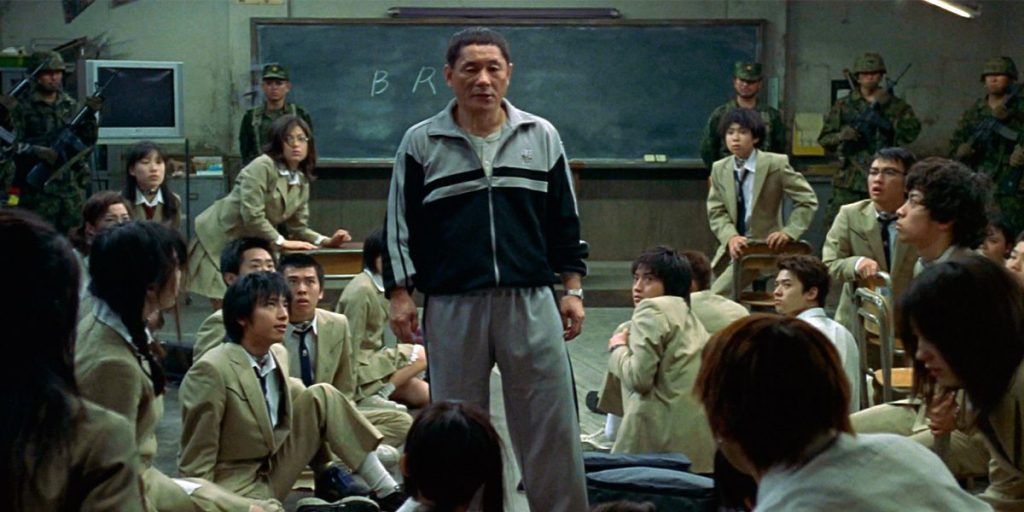Battle Royal
2000

Rated: NR
Genre: Action, Thriller, Dark Comedy, Horror
Country: Japan
Run-Time: 1h 54min
Director: Kinji Fukasaku
Cast
Tatsuya Fujiwara…………Shuya Nanahara
Aki Maeda………………………Noriko Nakagawa
Takeshi Kitano………………Kitano
Kou Shibasaki……………….Mitsuko Souma
How many films can say that an entire genre was named after it?
When Battle Royale was released in 2000, it caused quite a stir. Youth crimes were on the rise in Japan, so there was political momentum to ban the film after Japanese politicians failed to ban the novel it was based on. The main point of controversy was the story’s depiction of fifteen-year-olds graphically slaughtering one another in an only-the-winner-survives contest. Director Kinji Fukasaku resisted changing the film and it received a 16 plus rating in Japan, but the domestic controversy caused a ripple effect when the film was looking for international distributors and Battle Royale never saw a theatrical release in several countries, including the United States.
Ironically, it is also the film I used to introduce my teenage son to foreign gore. Fukasaku, who encouraged Japanese kids to sneak into theaters to see his film, would be proud.
However, finding a version of the film that wasn’t the poorly dubbed English version was a long and exhausting search. But believe me, it is well worth the extra effort to find the original Japanese language version with English subtitles. Even my son had a hard time taking the dubbed alternative seriously, especially since the subtitles and the dubbing don’t match and what is written in the subtitles was always so much better.
Now that we are over twenty years removed from its Japanese release and have seen a similar premise play out in the popular Hunger Games series (Suzanne Collins has stated that she had no knowledge of Battle Royale when writing her book), it is hard to understand what all the fuss was about. For a film that starts with a warning about the graphic nature of its content, Battle Royale feels a bit quaint.
Sadly, Battle Royale is also the last feature Kinji Fukasaku completed after his four-decade long career directing movies was ended by prostate cancer.
The story is set in a near-future Japan that is recovering from a deep recession. Youth crimes are on the rise, so leaders have passed the BR ACT as a means of deterrence. The idea is simple- randomly selected junior high school classes each year fight to death, with the winner getting a chance to live to see adulthood.
Fukasaku doesn’t put any effort into explaining how getting random classes of fifteen-year-olds to murder each other is expected to get youth to behave less lawlessly and considering how out-of-touch the students in this movie are with current events, it is easy to conclude it wouldn’t. So even though the BR ACT is said to be a deterrent, Kukasaku depicts the law more as a collective act of cathartic vengeance enacted by enraged adults frustrated by their weakened authority.
Fukasaku does a decent job casting young actors for their parts. A lot of the cast look like actual fifteen-year-olds. Others, like the “transfer students” who are really ringers brought in to keep things exciting, look much, much older. As expected, many of the characters fit the archetypal stereotypes we might expect to find in any survivalist film. Tatsuya Fujiwara plays Shuya Nanahara, the film’s main protagonist and moral compass. He is motivated to keep his best friend, Yoshitoki, crush alive after Yoshitoki meets an early, violent end. Noriko Nakagawa, played by Aki Maeda, is a paragon of innocence and appears completely out of place in a fight to the death contest. In contrast, sociopathic femme-fatal (and fan-favourite) Mitsuko Souma (Kou Shibasaki) finds killing surprisingly easy. We also get scenes play out with geeks and hackers, unconfessed crushes, and classroom rivalries. Many characters are introduced only to soon meet their demise a few scenes later, providing us a snapshot into a lived history between schoolmates that is quickly evaporating.
But for me, the performances by the young actors are all overshadowed by Takeshi Kitano’s portrayal of a fed-up ex-schoolteacher who has no remorse about putting his former students through hell. In truth, he is one of my favourite movie villains and I can re-watch that sequence when he tells the students the rules to the game on repeat for hours and never get bored. (To truly appreciate his performance, you really need to see this film in Japanese.) I must confess that I identify a little too much with the sadistic “I got-you-bastards” glee he takes in taunting the children. After all, has every adult has felt that way at one point.
But one of the most genius, entertaining ideas in the film was the random dispersing of weapons, if you can even call some of them that, given at the beginning of the film. Right from the get-go, some students find themselves at a huge disadvantage. How are binoculars going to save you when you come face-to-face with a student wielding a machine gun? The weapons disparity adds an extra level of fun to the already entertaining proceedings.
Battle Royale ended up being the perfect film to bond with my son over. Since then, we have started to watch some John Carpenter films. He is starting to show faith in my movie recommendations, which is nice. There is a gory realism to the violence in Battle Royale that puts later dystopian YA fiction to shame. It makes some very powerful statements about violence and trust. But Battle Royale also serves as a powerful metaphor for how each generation leaves the one after a little worse. The children in this film are victims being robbed of a future their parents had an opportunity to enjoy- one we see in flashbacks that most of them squandered. But at least these adults were given the chance to live full lives.
Parental guidance is just that. I recommend watching this one with your own teenager…if you have one. Enjoy it while it is playing and talk about it afterwards. Fukasaku’s last film contains a surprising amount of substance for young minds- and cinephiles- to absorb.
